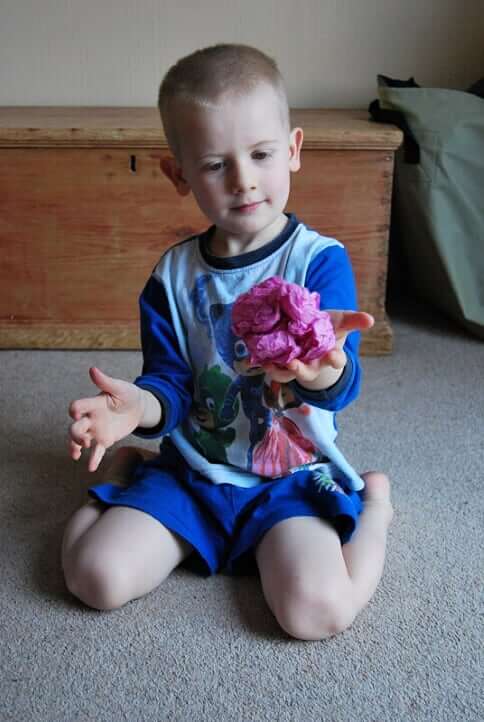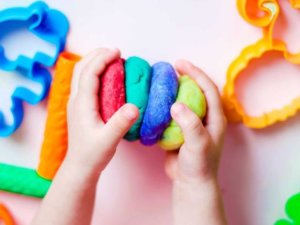10 calming and regulating activities for children with ADHD

Before trying these exercises, take a minute to prepare your child. To wake up their muscles, squeeze their hands, tips of their fingers and their arms and shoulders. You could also use a brush along their skin, or a vibrating massager. All of these can help to make your child more aware of their body which can then help them be more accurate and effective in their movements.
If your child has any tightness in their arm or hands, give them a good stretch before these activities to enable them to be as successful as possible.
Remember to praise the effort undertaken rather than the result achieved. This motivates the child to keep putting in effort and not be put off if they don’t succeed at first.
Fun Shoulder and Elbow Strengthening Exercises
 This exercise works well coupled with a focus on breathing control. Perhaps suggest holding each posture for five slow breaths. Some children respond to being competitive, by holding a pose for a specific period of time.
This exercise works well coupled with a focus on breathing control. Perhaps suggest holding each posture for five slow breaths. Some children respond to being competitive, by holding a pose for a specific period of time.
On hands and knees: reach one arm straight out in front in the air, like Superman! You can challenge the child to balance a beanbag or soft toy on the back of their hand to keep it up. Try and hold for one minute.
Put arm down and lift one leg up straight out behind. Try and hold this for one minute.
See if your child can hold an opposite arm and leg out at the same time and hold it for one minute? This will challenge their shoulder, elbow and hand stability muscles.
Try the other side.
Hold your child by their hips with their legs straddling you and their hands on the floor. Move around the floor picking up objects for as far as you can go.

Move your hands down to your child’s knees and walk around the room – picking up objects or playing a matching game or skittles.
If you can, hold your child by their ankles. Make sure they keep their bottom in the air and don’t hang their tummy down. Again, a game can make this more entertaining.
As your child gets stronger you could try to get from one end of the house to the other – even trying going up any steps or the stairs.
You could also make an obstacle course to go around or over.

Any climbing provides resistance and strong proprioceptive input, especially through the arms and hands. This includes climbing on furniture or up the stairs. The more weight which goes through the arms, the better.
The most challenging activity is hanging on a bar or going along monkey bars. Commercially available “chin up” or gymnastic bars might be an option for you to try. Otherwise, if it’s safe try getting your child to hang off a door or cabin bed frame – supervision is required here.
Wrist, Hand and Arm Strengthening Activities
See this ‘Our Home’ video on hand strengthening with playdough – kneading, pulling apart, squashing or wringing the playdough can all be great hand strengthening exercises.

There is commercially available therapy putty with graded resistance which many children enjoy playing with. As a general guide, red/ medium soft is good for primary school children with green and blue being more resistive for older or stronger children.
For added novelty, try hiding objects in the dough and your child has to manipulate it to get the toy.
Many children find the repetitive kneading and pulling of resistive materials calming and relaxing when feeling irritable.
We have different adaptions on our YouTube channel including salt dough in a plastic bag for those who are hypersensitive to touch and sensory dough recipes.
Cut a piece of hard card into a head shape. Your child can draw on a face and use the clothes pegs to make hair.
Wrap string around some chair legs and peg pegs to the string for your child to remove.

Peg the whole of your peg bag to the clothes your child is wearing. This can be very funny and a welcome distraction if feeling irritable or bored. Then unpeg. They may find someone else willing to be “pegged”…!
Do a scavenger hunt. Clip pegs around the house on bits of material, paper, drawer handles etc. The child can then go around the house or the room (depending on their mobility) to find the pegs and take them off. See this ‘Our Home’ video which shows how to use a tablet to set up a scavenger hunt.

Using home implements can be brilliant for resistance activities. To build whole hand strength use kitchen or BBQ tongs to pick up bigger items such as socks, soft toys, small cushions.
You could set this up as a scavenger hunt too. Take photos of objects they need to pick up with their tongs from around the home or room and bring back to you.
Collect any spare nuts and bolts (and washers) you have around the house.
Cut out a shape in card (dinosaur, snake, tree – whatever your child would like) and cut small holes or slits into it.
Your child can amuse themselves threading the bolts through the holes and screwing the nuts and washers onto them to make some cool 3D art.

Use a large piece of newspaper or junk mail and ask your child to scrunch it into the smallest ball they can with two hands.
Now ask them to do it with one hand. This is surprisingly challenging – they cannot use their tummies to cheat!
You can create a target to throw at – maybe the recycling bin?!
This is also a great fun warm-up for drawing and writing activities as it activates the muscles needed for pencil control.
Squeezing bottles is a great resistive activity. Fill an empty toothpaste tube with liquid or yogurt or a bottle with a spout with any liquid and have fun squeezing the liquid out.
Put soft salt/playdough in a plastic bag and make a small hole – squeezing it out can make a lovely snake of dough.
Squeeze stress balls: encourage your child to squeeze this or just poke into it with their fingers. See our ‘Our Home’ video for an easy way to make a stress ball.
Activities using scissors should be supervised at all times!
 Using scissors is a great way to strengthen hands. You can start by cutting dough as this teaches the right way to cut. Make a snake out of dough and ask then to cut it into pieces.
Using scissors is a great way to strengthen hands. You can start by cutting dough as this teaches the right way to cut. Make a snake out of dough and ask then to cut it into pieces.As their skills develop you can be inventive with your cutting and draw interesting shapes for them to cut. Try using old birthday cards, aluminium foil, egg boxes or the crinkly insides of biscuit and chocolate boxes.
Start junk modelling with your recycling items- this builds imagination, planning and attention to a task that is helpful for children with ADHD.
See ‘Our Home‘ for a great demonstration of making chain Minecraft men with just straight line cutting.
Here are a selection of suitable videos
Salt Dough
Make your Own Stress Balls
Scavenger Hunt
Make a Minecraft person
Thank you for visiting Gympanzees’ website. All information provided by Gympanzees is of general nature and for educational / entertainment purposes. It is up to you as the parent or family member to judge what is appropriate and safe for your child. No information provided by Gympanzees should replace any professional information and advice that you have been given and speak to your therapist or doctor if you are unsure of anything. Should you use any of the information provided by Gympanzees, you do so at your own risk and hold Gympanzees harmless from any and all losses, liabilities, injuries or damages resulting from any and all claims.






